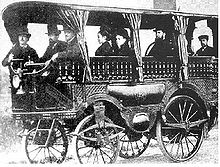Steam bus


Steam buses are steam car ( buses ), which in the 19th century in England and France were used. The exterior of the steam bus is reminiscent of a carriage . It was run on coke . The bus offered an average of 8 to 18 (often 14) passengers, some of which were covered. The driver usually sat high up in an uncovered place.
history
The Englishman Sir Goldsworthy Gurney , who constructed the first steam bus in 1826, can be regarded as the inventor . But his compatriot Walter Hancock is also often referred to as the inventor. Hancock received a patent for a steam-powered road vehicle in 1827 and built the Infant , a ten-seater in 1831, which he first used on the Stratford– London route and later between London and Brighton. In 1833 the inventor put the Enterprise, specially designed as an omnibus, into operation. As a means of public transport, this vehicle commuted between London, Islington and Paddington for the London and Paddington Steam Carriage Company. At the premiere, however, he is said to have been pelted with stones by viewers. The British Museum preserves a contemporary etching of the Enterprise . Another Hancock steam bus was the Automaton .
The Austrian optician Peter Wilhelm Friedrich von Voigtländer bought Hancock's eighth car in 1834 for around £ 600. He had the vehicle (“steam train cart”) transported to Vienna with four horses and exhibited it in the Vienna Prater for an entrance fee. On October 26, 1834, Voigtländer then drove the vehicle in the Hauptallee in front of 15,000 spectators. However, the original railway project for a connection between Vienna and Pressburg was never realized and the vehicle was sold to Russia.
The first vehicles of this type drove up to 15 km / h. Mainly the steam bus drove between London and its suburbs. In 1836 there were 700 trips. In 1865 the Red Flag Act set a speed limit: in places up to 3 km / h and outside up to 6 km / h. Due to this limit, the steam car became less and less important.
In 1867, Robert William Thomson patented the Road Steamer, a tractor with an upright boiler and solid rubber tires, which was also used in passenger transport. One line served Edinburgh and Leith in Scotland around 1870 .
It was not until 1896 that the “Red Flag Act” was repealed. This marked the beginning of the triumphant advance of the gasoline-powered bus in Great Britain as well. Steam buses lasted in London until 1919 and in the rest of Great Britain until 1923.
The Frenchman Amédée Bollee built in 1873 in his company a 40-km / h new steam bus called L'Obéissante (see picture).
Steam buses were initially in competition with the steam train that was emerging at the same time . The advantage of not being rail-bound , however, was offset by a few disadvantages. Particularly inadequate steering behavior and inadequate brakes were criticized in several designs.
Individual evidence
- ↑ Steam bus Prater (PDF; 3.8 MB) in Jutta Czabaun: The reactions of the population to early automobilism in Austria . Diploma thesis, University of Vienna 2008, p. 24 f, accessed on June 14, 2012
- ↑ Grace's Guide: Robert William Thomson.
- ^ P. Gould.
